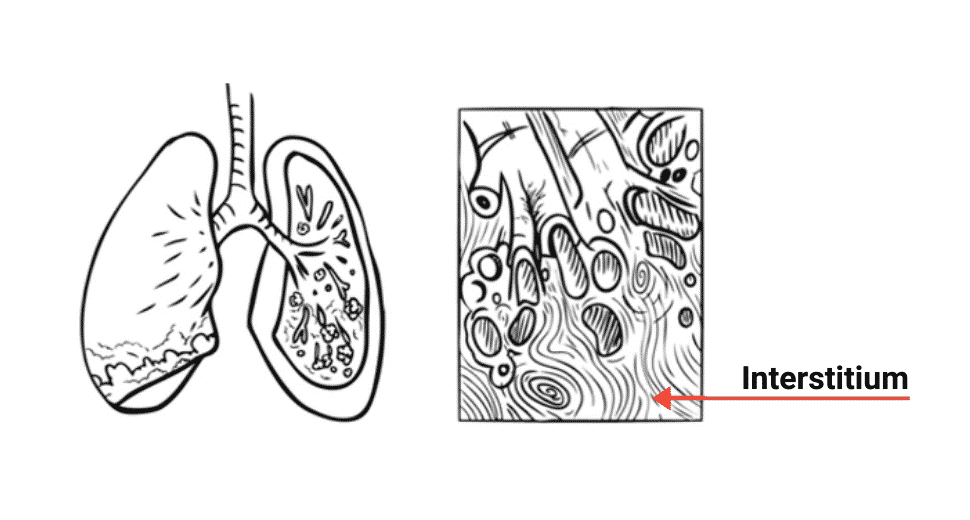PULMONARY FIBROSIS - General Information
What is Pulmonary Fibrosis?
Pulmonary Fibrosis (also known as interstitial lung disease) is a disease that can affect every part of your life. As the disease progresses, so will its impact on your life and your daily activities. The exacerbations of the disease, or period of worsening symptoms can greatly affect your quality of life.
Pulmonary fibrosis is a disease characterized by progressive scarring in the lungs. Scar formation causes the lung interstitium (part of the lung where gas exchange occurs) to become thicker and stiffer. After you breathe in, oxygen needs to diffuse through the interstitium to reach the blood circulation. In pulmonary fibrosis, the thickened interstitium makes it harder for the oxygen to reach the blood circulation.
Healthy Lung

Fibrotic Lung

How is the diagnosis of Pulmonary Fibrosis made?
Diagnosing pulmonary fibrosis and identifying the precise type of fibrosis is a challenging process. This disease may be difficult to diagnose and you may need to see many doctors before knowing what type of pulmonary fibrosis you have. Many tests including pulmonary function tests, medical imagery and blood tests may be necessary to determine the type of pulmonary fibrosis you have.
Learn more about this topic by downloading your free personal copy of “Dealing with a diagnosis of Pulmonary Fibrosis” of the Living Well with Pulmonary Fibrosis program.
To consult the full program, sign-up to LivingWellWithPulmonaryFibrosis.com. When creating your privileged access (always FREE), you will benefit from general information brochures, learning documentation, videos and more.
Diagnosing pulmonary fibrosis and identifying the precise type of fibrosis is a challenging process
How is Pulmonary Fibrosis managed?
Treatment of pulmonary fibrosis takes many forms and may change throughout the course of your disease. It is important to follow all treatment plans as prescribed by your physician.
A comprehensive treatment plan includes the following:
- Take your medication as prescribed (Anti-fibrotic medication, immunosuppressive medication). Medications do not cure pulmonary fibrosis – but they may help reduce the progression of the disease if taken as directed by your doctor
- Prevent and control flare-ups or worsening of symptoms, and when needed take the medications to treat them
- For some people who are eligible, having a lung transplant
- Engage in physical activity and exercise. If you need support, you may join a pulmonary rehabilitation program
- For certain, doctors may also recommend Oxygen therapy
- Make changes to your lifestyle to stay healthy
There are many ways in which you can learn about the treatments for pulmonary fibrosis and how they can help you better live with this disease.
Can people with Pulmonary Fibrosis get better?
A diagnosis of pulmonary fibrosis can change the way you see yourself. You may feel trapped, isolated, of no use to your family and friends. You may feel hopeless. These are common reactions.
But remember, you are not alone and there are many ways in which you can learn about how to regain control of your life with pulmonary fibrosis. You can discuss your concerns with your doctor or resource person. Patient support groups are a very helpful resource for gaining understanding of how to deal with the disease.
There are things that you can do to help you live well with this disease. The Living Well with Pulmonary Fibrosis program offers information and support for each of these topics. The best way to learn more about Pulmonary Fibrosis is to work together with your healthcare team that will be able to provide you with the information and support specifically suited to your needs.
The program consists of the following modules:
- Dealing with a Diagnosis of Pulmonary Fibrosis
- Adopting & Maintaining a Healthy & Fulfilling Lifestyle
- Treating Pulmonary Fibrosis
- Managing the Impact of Pulmonary Fibrosis
- An Action Plan for When Your Symptoms Get Worse
- Get Moving...Breathe Easy with Pulmonary Fibrosis
- Integrating Long-Term Oxygen Therapy Into Your Life
- Pulmonary Fibrosis & End of Life
To consult the full program, sign-up to LivingWellWithPulmonaryFibrosis.com. When creating your privileged access (always FREE), you will benefit from a multitude of documents developed over the years, including general information brochures, learning documentation, videos and more. Additionally, healthcare professionals can access tools specifically designed to support your teaching.
you are not alone & there are many ways in which you can learn about how to regain control of your life with pulmonary fibrosis.

